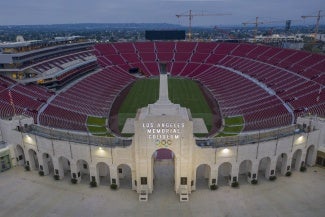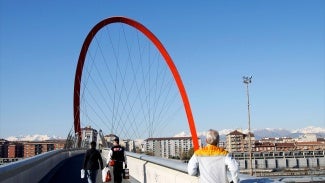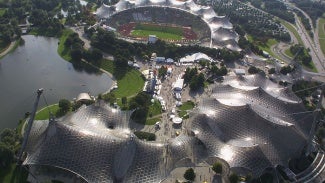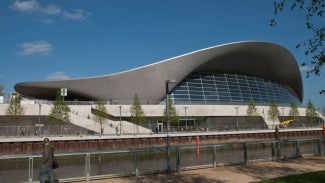
Six must-know Olympic landmarks for architecture lovers
As the 2024 Summer Games kick off in Paris, we look back at Olympic venues that have stood the test of time.
Are you breathlessly awaiting the results of this year’s artistic swimming competition at the 2024 Paris Olympics? Maybe you’re more of a canoe slalom, beach volleyball or badminton fan. Regardless of what you’re most looking forward to, the good news is that the Games of the XXXIII Olympiad kicked off on Friday, July 26, continuing a modern tradition of international sportsmanship and competition that started in 1896 in Athens, Greece.
With every set of Olympic games comes a necessary overhaul of the host city’s built environment – often including billions of dollars in transportation and infrastructure investments. The purpose-built stadiums and sporting venues are, of course, the most high-profile and iconic part of these changes, and they often remain as tangible reminders of the spirit of the games long after the closing ceremony.
Here at AIA, we were fascinated to learn that at one point in time, Olympic medals were awarded in five decidedly non-athletic categories: architecture, literature, music, painting and sculpture. Starting in 1912 at the Stockholm Olympics, judges assessed works in each of these categories. They were only allowed to score pieces that had never been exhibited anywhere else. The medals awarded in architecture were for town planning – a fitting category for an event where a village designed to contain thousands of athletes is suddenly populated overnight. Although unfortunately not eligible for a gold medal, this year’s Olympic village was designed by French architect Dominique Perrault.
While Olympic structures don’t always stand the test of time, we’ve rounded up five examples below that are enjoying second lives after being built for Olympic games all over the world.
Los Angeles Memorial Coliseum, Los Angeles, 1932 and 1984 [pictured above]
Architects: John and Donald Parkinson, renovations by DLR Group
Commissioned in 1921 as a memorial to Los Angeles veterans of WWI and completed in 1923, this coliseum will join an elite club in 2028 as one of only a handful of venues in the world to host three separate Olympic games. It was designated a National Historic Landmark on July 27, 1984, a day before the opening ceremony of the 1984 Summer Olympics.
Originally designed by architects John and Donald Parkinson, a major renovation of the stadium overseen by global firm DLR Group was completed in 2019. After serving as the home to three professional sports teams over the years – the Rams, Raiders and Dodgers – it now serves as the primary home of the University of Southern California Trojans football team.

Olympic Arch, Turin, 2006
Architect: Camerana&Partners
This distinctive red steel arch welcomed athletes and spectators to Turin, Italy, in 2006 for that year’s Winter Games. Designed by Turin-based firm Camerana&Partners, the arch and its connected walkway linked the Olympic Village with the nearby Lingotto building complex, which includes a multipurpose center designed by Renzo Piano.
The Turin 2006 Olympics are still seen as innovative for being the first European-based Winter Games to adopt a city/mountain hosting model. Ice-based sports were held in the metropolitan center, while the nearby mountains hosted skiing and snowboarding events.
In 2019, the Olympic Arch was named a national work of art by the Italian ministry of culture and art. “It is a symbol that, along with many others, changes the city skyline, but that also stands as proof of the larger process of renewal this city has embarked upon,” remarked Turin mayor Sergio Champarino at the time.

National Stadium, Beijing, 2008
Architects/designers: Ai Weiwei, Pierre de Meuron, Jacques Herzog, Li Xinggang
Originally constructed for the 2008 Summer Olympics and utilized during the 2022 Winter games, Beijing’s National Stadium is nicknamed the Bird’s Nest – and it’s easy to see why. The crisscrossing steel beams were originally designed to camouflage a retractable roof, plans which were ultimately scrapped due to engineering concerns.
The Swiss architecture firm Herzog & de Meuron won the bid for the stadium, in partnership with Chinese architect Li Xinggang of China Architecture Design and Research Group (CADG), with a design inspired by Chinese ceramics. Ai Weiwei, the internationally renowned Chinese artist, served as artistic consultant on the project.
Today, the stadium hosts a variety of music and sporting events.

Munich Olympic Stadium, Munich, 1972
Architects: Gunther Behnisch, Frei Otto
The lightweight tent construction of Olympiastadion in Munich, which hosted in the 1972 Summer Games, was considered revolutionary for its time. Large sweeping canopies of acrylic glass, stabilized by steel cables, were used for the first time on a large scale. One of the stadium’s selling points for the jury involved in the design selection process was its potential for reuse.
Architect Gunther Behnisch read about engineer Frei Otto’s tent roof construction at the Montreal World Fair in the newspaper, and he knew he wanted him as a partner architect on the project. Otto had previously been involved in numerous construction projects with suspended and membrane structures.
After the Olympics, the stadium became the home of German soccer team FC Bayern Munich and has hosted a variety of athletic and sports events, including the 1974 FIFA World Cup. It has also hosted stadium concerts by artists like the Rolling Stones, Tina Turner, and Pink Floyd. It will be the venue for Taylor Swift’s Eras Tour at the end of July 2024.

Lluís Companys Olympic Stadium, Barcelona, 1992
Architects: Pere Domènech i Roura, Vittorio Gregotti
Originally built for the 1929 Barcelona International Exposition, the Lluís Companys Olympic Stadium was designed by architect Pere Domènech i Roura and hosted rugby and soccer matches after the exposition. It underwent a complete renovation during Barcelona’s bid for the 1992 Summer Olympics under the direction of Italian architect Vittorio Gregotti.
In 2001, the stadium received its present name, honoring the former president of the Government of Catalonia who was executed at the nearby Montjuïc Castle by the Franco regime. It served as the home of the Barcelona Dragons American Football team from 1991 until 2002, as well as the NFL’s American Bowl in 1993 and 1994. It is currently serving as the home of the Barcelona soccer club during the renovation of their Camp Nou stadium.

London Aquatics Center, London, 2012
Architect: Zaha Hadid
The dramatic swoop of the London Acquatics Center roofline makes it one of the most distinctive and instantly recognizable Olympic venues, but its sleek and effortless appearance belies a laborious design, specification and construction process. Designed by Pritzker Prize winner Zaha Hadid, who completed her initial design in 2004 in preparation for the 2012 Summer Olympics, the estimated cost of the center nearly doubled after a specification change, and she was forced to revise her plans. When the Aquatic Center was completed in 2011, it ultimately cost three times its original estimate, at £269 million.
Today, the concrete, steel, aluminum and timber structure hosts swimming and diving events and is open to the public for an admission fee.
